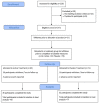Effectiveness of "Moro" Blood Orange Citrus sinensis Osbeck (Rutaceae) Standardized Extract on Weight Loss in Overweight but Otherwise Healthy Men and Women-A Randomized Double-Blind Placebo-Controlled Study
- PMID: 35276783
- PMCID: PMC8838101
- DOI: 10.3390/nu14030427
Effectiveness of "Moro" Blood Orange Citrus sinensis Osbeck (Rutaceae) Standardized Extract on Weight Loss in Overweight but Otherwise Healthy Men and Women-A Randomized Double-Blind Placebo-Controlled Study
Abstract
This study aimed to assess the efficacy of a blood orange Citrus sinensis standardized extract from “Moro” cultivar, on weight loss in overweight but otherwise healthy individuals. Anthocyanins and particularly cyanidin 3-glucoside, found in a large variety of fruits including Sicilian blood oranges, can help to counteract weight gain and to reduce body fat accumulation through the modulation of antioxidant, anti-inflammatory and metabolic pathways. In this randomized, double blind, placebo-controlled study, all participants (overweight adults aged 20−65 years old) were randomized to receive either Moro blood orange standardized extract or a placebo daily for 6-months. The primary outcome measure was change in body mass and body composition at the end of the study. After 6-months, body mass (4.2% vs. 2.2%, p = 0.015), body mass index (p = 0.019), hip (3.4 cm vs. 2.0 cm, p = 0.049) and waist (3.9 cm vs. 1.7 cm, p = 0.017) circumferences, fat mass (p = 0.012) and fat distribution (visceral and subcutaneous fat p = 0.018 and 0.006, respectively) were all significantly better in the extract supplemented group compared to the placebo (p < 0.05). In addition, all safety markers of liver toxicity were within the normal range throughout the study for both analyzed groups. Concluding, the present study demonstrates that Moro blood orange standardized extract may be a safe and effective option for helping with weight loss when used in conjunction with diet and exercise.
Keywords: BMI; body mass; cyanidin 3-glucoside; fat distribution; flavonoids; physical activity.
Conflict of interest statement
The authors declare no conflict of interest. The funders had no role in the design of the study; in the collection, analyses, or interpretation of data; in the writing of the manuscript, or in the decision to publish the results.
Figures




References
-
- World Health Organisation Obesity and Overweight. [(accessed on 1 April 2020)]. Available online: www.who.int/news-room/fact-sheets/detail/obesity-and-overweight.
Publication types
MeSH terms
Substances
Grants and funding
LinkOut - more resources
Full Text Sources

